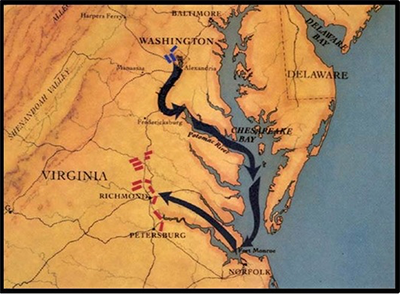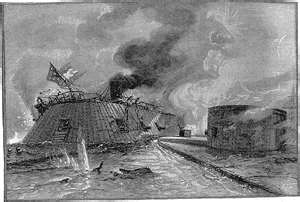The American Civil War
Part 3: Along the Peninsula
Not long afterward, Stonewall Jackson embarked on his Shenandoah Valley Campaign, employing a handful of techniques of sleight-of-hand and scoring several victories over Nathaniel Banks and other Union commanders. One result of this was that the Union diverted to the area a contingent of troops that would otherwise have been headed toward Richmond. While McClellan continued to make painstaking preparations for his new Peninsula Campaign, Southern troops moved to a new position along the Rappahannock. The ever cautious McClellan had to revise his plans yet again. The Army of the Potomac finally moved against the enemy but then allowed them to escape. McClellan had, among other experiences, had great exposure to the siege network employed at Sebastapol during the Crimean War. At Yorktown, the similar preparations that he directed took so long that the Confederate commander Johnston was able to bring in reinforcements. After the two armies clashed at Williamsburg, Johnston withdrew and McClellan did not follow, preferring to pause and regroup. In frustration, Lincoln removed McClellan as his top general, on March 11. McClellan was still in command of an army, though. 
The lumbering Union army, the largest American military force ever assembled, pursued their Confederate opponents further into Virginia. The two forces clashed on May 31 at Seven Pines. Casualties were high and the result inconclusive, and the Union army was only four miles from Richmond; McClellan, however, was convinced that defeat was just around the corner and waited three weeks for reinforcements. During that time, another force under Gen. Robert E. Lee attacked the Union troops. McClellan pulled back and fell into the Seven Days Battles, ending up at Harrison's Landing on the James River, supported by U.S. Navy gunships. He eventually headed back north, and Lincoln replaced McClellan as general-in-chief with Henry Halleck. With McClellan tied down, Lee moved north and guided the South to another victory at Bull Run/Manassas, on Aug. 28–30. Commanding the newly formed Army of Virginia at that battle was Major Gen. John Pope. Dismayed at Pope's defeat, Lincoln reluctantly reappointed McClellan to overall command of the army. McClellan responded by marching west to meet up with Pope's force and then target Lee's army, which had invaded Maryland. Next page > Antietam and Fredericksburg > Page 1, 2, 3, 4, 5, 6, 7, 8, 9, 10 |
|
Social Studies for Kids
copyright 2002–2025
David White



 In the East, a novel adaptation of technology resulted in the first all-metal naval battle, as the USS Monitor engaged the CSS Virginia (formerly the USS Merrimack) in a half day of futility. On March 9, 1862, in the
In the East, a novel adaptation of technology resulted in the first all-metal naval battle, as the USS Monitor engaged the CSS Virginia (formerly the USS Merrimack) in a half day of futility. On March 9, 1862, in the 
